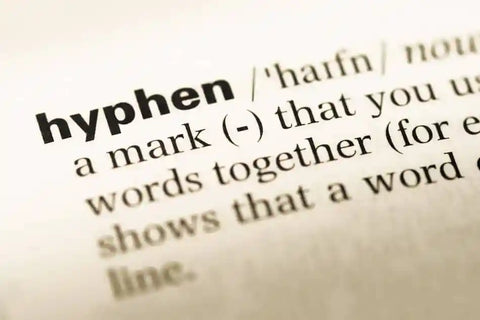應對有效連字的挑戰
沒有一套簡單的規則來規範英語中連字符的使用,這意味著在學術文章中建立一致的連字符系統可能非常棘手。困難很大程度上是由於使用連字符是否通常取決於單字或短語的上下文 - 即其特定作用及其在句子中的位置。一些學科有傳統的使用模式,因此您計劃提交學術或科學論文的期刊可能會提供指導方針,指示如何以及何時使用連字符。然而,這樣的細節極為罕見,作者指示更常見的是建議盡量減少連字符的使用。這是合理的建議:儘管一些連字符的術語是傳統的,但使用連字符通常具有相當大的主觀性,以闡明作者的意思,過多的連字符不僅會使文本變得混亂,使其難以辨認。
英語中正確的連字符模式通常因術語而異,並且與語言的許多其他方面一樣,它們相當流暢,因此可以更改。例如,隨著時間的推移,帶有連字符的複合詞會隨著頻繁使用而變得封閉:從“on line”到“on-line”再到“online”的變化就是一個很好的例子。然而,一般來說,連字符在英式英語中的使用比在美式英語中更為廣泛,因此一本能夠提供有關該語言的一種或兩種形式的連字符使用建議的好詞典對於查找單詞和復合詞至關重要。除了在使用連字符時關注公認的模式和含義的清晰度之外,您還應確保每個帶連字符的元素在整篇文章中保持一致,並且以類似方式使用的類似單詞和短語具有類似的連字符,至少在可能和合理的情況下。但請記住,有些複合字需要用連字號連接,而其他類似的字則不需要。
軟連字符或浮動連字符會帶來不同的挑戰。上面討論的硬連字符是永久放置的,用於在複合詞的形成過程中連接單詞或單詞的一部分(或數字等其他元素),而軟連字符則用於在文本的行尾處分隔單詞,以在頁面上創建更平衡或更有吸引力的佈局。軟連字符在學術寫作中是不必要的,因為它們通常是透過自動連字符功能(例如 Microsoft Word 中的功能)添加到文件中的,而這往往會引入不適當的單字劃分,因此最好避免使用它們。如果您確實希望或需要使用自動連字符,請務必掃描文字中的行尾以查找誤導性劃分:例如,「exact-ing」和「re-appear」是「exacting」和「reappear」的可接受劃分,但「ex-acting」和「reap-pear」則不是。
但是,無論是否使用自動連字符,如果列太窄而無法容納單詞,表格列中出現的單字有時會以無意義且分散注意力的方式被分割。例如,「百分比」一詞可能會被錯誤地分成三行,讀作「perc-enta-ge」。在旨在以引人注目且易於理解的視覺形式報告資料的表格中,此類錯誤既不美觀也不專業,因此如果您在文章中包含表格,請務必注意這些錯誤。如果有必要,可以使用縮寫,使相關表格中的列稍微寬一些,以便為單字提供足夠的空間,或者重新建立表格,以便有足夠的空間讓標題以清晰的方式顯示。
為什麼選擇我們的編輯和校對服務?
在 Proof-Reading-Service.com,我們透過龐大且極其敬業的學術和科學專業團隊提供最高品質的期刊文章編輯、論文校對和線上校對服務。我們所有的校對人員都是英語母語人士,擁有研究生學位,他們的專業領域涵蓋了廣泛的學科,因此我們能夠幫助我們的國際客戶進行研究編輯,以改進和完善各種學術手稿,從而成功出版。我們的稿件編輯和校對團隊中許多經過精心培訓的成員主要負責擬在學術期刊上發表的文章,運用嚴格的期刊編輯標準,確保每篇論文中使用的參考文獻和格式符合期刊對作者的指示,並糾正任何語法、拼寫、標點或簡單的打字錯誤。透過這種方式,我們使客戶能夠以清晰準確的方式報告他們的研究,以打動收購校對員並實現出版。
我們為各種科學期刊論文的作者提供的科學校對服務尤其受歡迎,但我們也提供手稿校對服務,並擁有校對和編輯所有學術學科以及其他學科手稿的經驗和專業知識。我們的團隊成員專門從事醫學校對服務,我們的一些專家專門致力於論文校對和手稿校對,透過最嚴格的博士論文編輯和期刊文章校對實踐,為學者提供提高格式和語言使用能力的機會。無論您是在準備會議論文以供展示,完善進度報告以供與同事分享,還是面臨編輯和完善任何類型學術文獻以供出版的艱鉅任務,我們專業團隊的合格成員都可以提供寶貴的幫助,讓您對您的書面作品更有信心。
如果您正在為學術或科學期刊準備一篇文章,或者計劃在不久的將來實現這一目標,那麼您可能會對一本新書《期刊出版指南》感興趣,該書可在我們的「期刊發表研究成果的技巧和建議」網站上找到。








